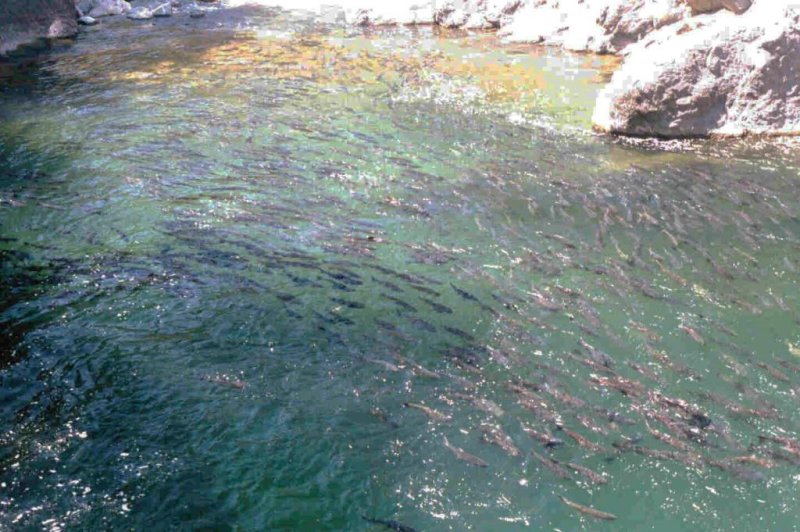Spring-run and fall-run Chinook salmon both spawn in the fall, but spring-run salmon -- pictured here in Northern California's Butte Creek -- migrate upriver early in the year and spend the summer in cool, deep pools. Photo by Allen Harthorn
Oct. 30 (UPI) -- Traditionally, spring-run and fall-run Chinook salmon have been classified as two separate subspecies, or ecotypes, but new genetic analysis suggests the two groups are much more similar than they are different.
According to the new study, published this week in the journal Science, the migration patterns of spring-run and fall-run Chinook salmon are dictated by differences in a small snippet of DNA in their genomes.
"Understanding the genetic basis of ecotypic differentiation in salmon provides a solid framework for predicting the outcome of different management actions," study co-author John Carlos Garza, professor of ocean sciences at the University of California, Santa Cruz, told UPI in an email.
Scientists previously observed evidence that members of the same Chinook salmon lineages switch between fall and spring migrations. The new research showed spring-run and fall-run Chinook salmon are indeed two versions of the same fish, like a brother and sister with different colored hair.
When researchers compared the genomes of spring-run and fall-run Chinook salmon, they discovered two versions of a set of genes in a part of the genome scientists dubbed the Region of Strongest Association, or RoSA -- an E version for early migration and L version for late migration.
Because these versions, or variations, feature a handful of switched-around genes -- not just one -- they're called haplotypes.
And since salmon offspring inherit a chromosome from both their mother and father, they can boast one of three different RoSA haplotypes: EE, LL or EL. Since these haplotypes trigger different behaviors, or traits, they're also referred to as genotypes.
When researchers sampled and analyzed more than 500 salmon caught by the Yurok Tribe in the Klamath River Estuary of Northern California, they found no overlap in the migrations of fish with EE and LL genotypes.
Researchers found EL fish tended to overlap mostly with spring-run fish, but some EL fish were also found migrating alongside fall-run salmon. The abundance of EL fish, they said, suggests fall-run and spring-run salmon regularly interbreed.
As part of the study, researchers analyzed genetic samples from post-spawning salmon carcasses in a handful of rivers throughout northern California, as well as Oregon's Siletz River. The survey turned up EL genotype fish in every river where both spring- and fall-run salmon are found.
"We also performed an elegant simulation analysis that found that the proportion of combinations of gene variants inside and outside of the core region found in the genomes of Klamath salmon could not have arisen through interbreeding in the period of large-scale human manipulation of the basin," Garza said. "So it is a natural process that has been going on for a long time."
The survey data and genomic modeling also proved the ecotype variations present among Chinook salmon evolved at least 180 years ago. That's good news for the project of salmon conservation in the Klamath River, the researchers said.
For decades, damming has prevented a spring run in the upper reaches of the Klamath River Klamath River.
As the construction of dams depleted cool water refuges in the Klamath, spring-run salmon, which must spend the summers in freshwater, were depleted. But the latest research suggests the migration pattern has been preserved in populations of nearby salmon.
"The finding that the E haplotype is highly conserved across Chinook salmon lineages -- i.e. it is much more similar in those lineages than the rest of the genome -- means that the same ancient mechanism underlies the early migration phenotype throughout our study area," Garza said.
That means a spring run can be reestablished -- once their habitat has been restored via major dam removals -- by introducing or cross-breeding fish carrying the E lineage into a predominately fall-run population.















